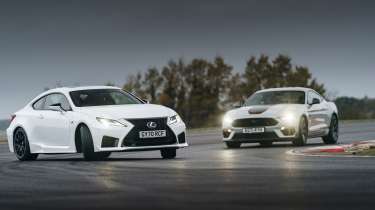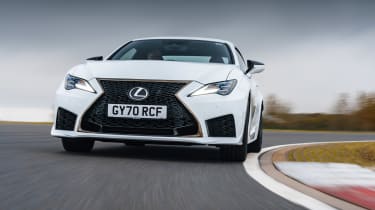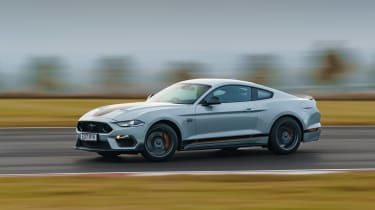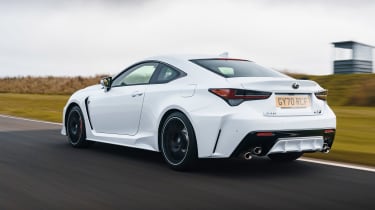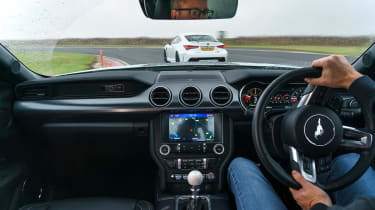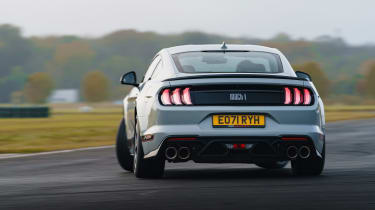Ford Mustang Mach 1 v Lexus RC F – rear-drive V8 coupes go head-to-head
Ford’s Mustang Mach 1 and Lexus’s RC F are two contrasting but equally compelling takes on the old-school V8-engined rear-drive coupe. We compare them on road and track
Here are two examples of a rare automotive breed that is becoming rarer with each passing day. Not only do they share body styles (both two-door sports coupes) and mechanical philosophy (both 5-litre V8s, not a turbo in sight, and strictly rear-wheel drive only), but when they’ve burnt their last drop of E5 98 RON their replacements are destined to follow them in name only. In fact the Mustang is already evolving into its future self in the guise of the Mach-E, an all-electric SUV, and Lexus recently teased a new electric sports coupe that will glide into the slot the RC F will vacate in the company’s product line‑up in a few years’ time.
Ford’s sixth-generation Mustang, here in Mach 1 guise, needs little introduction, is a firm evo favourite and is as straightforward a performance car as they come. It’s a (relatively) affordable gateway for anyone looking for front-engined, rear-drive thrills in a car that takes a route-one approach by keeping it simple – as opposed to rivals that require you to read the manual (online, naturally) and watch an instructional video before you can enjoy what they’re capable of. Which almost invariably is more than you need for the road – or could get away with on a trackday…
> Used Ford Fiesta ST (2018-present) review and buyer’s guide
With the Mustang’s combination of 454bhp, a limited-slip diff, a manual gearbox and a chassis that’s up for as much fun as you care to throw at it, simple thrills are rarely this accessible this side of a Caterham Seven. You’d need to be a pretty heartless soul not to enjoy the charms and character of the world’s biggest-selling sports car (over 80,000 were sold in 2020 alone). In a world of turbocharged, all-wheel-drive, double-clutched coupes derived from saloons and estates cars, the Mustang has always stood out as the alternative choice, and in our book a very good one at that.
Lexus’s RC F has never come close to the Stang’s sales success, but the Japanese approach to a large-capacity front-engined, rear-drive V8 coupe also has many ardent admirers – us included. Lexus has sold just 7000 RC Fs since its European debut in 2015, but its rarity adds to its appeal and seven years on it still offers something unique and special for those looking for just that.
It’s still a sharp piece of automotive design, its jutting nose matched with a pair of box rear arches, the whole car wearing an aluminium body pulled tight at each corner, with not an ounce of body fat on show. In comparison, the Mustang looks bulky, like it could do with a few more gym sessions to sharpen it up. In fact both are packing the pounds, the Ford marginally the lighter of the two at 1754kg, the Lexus 11kg more. There is only 10mm in it when it comes to the wheelbase, the Lexus’s 2730mm the longer of the two, and in terms of weight distribution it’s 54/46 for the Mach 1 and 55/45 for RC F. The Lexus is just ahead in the power stakes with 470bhp and 271bhp per ton (263bhp per ton for the Ford). Their cultures may be separated by an ocean, but these two could be brothers from a different mother.
There’s a crispness to the RC F’s V8 engine note when it awakens and settles at idle. The density of its soundtrack rests in the background, the exhaust tone a distance burble from behind your shoulders, the gentle pumping of eight cylinders ahead of you smooth as a six-cylinder with an underlying richness and depth that reminds you of a V8-engined BMW of the late ’90s.
The effect continues when you open the throttle, the needle sweeping around the RC F’s centrally positioned analogue rev-counter that’s set into the TFT instrument cluster, the soundtrack wrapping around you with a clarity to match the sound quality produced by the Mark Levinson stereo. What the Lexus lacks in BMW M and AMG-style headline-grabbing punch it makes up for with a sense of precision engineering flowing through its mechanical heart.
Step into the Ford and it’s blood and thunder in comparison. Its Coyote V8, which mixes regular Mustang V8 internals with elements from the GT350, including the intake manifold, leaves you in no doubt that the US of A likes its V8s loud and proud. At tickover it burbles with a gruffness you’d expect of a muscle car, and under load it’s no different, but compared to the Lexus’s motor its reactions are slower to your right foot’s inputs, the manner in which it builds momentum more one-dimensional, albeit no less effective.
On a give-and-take road, the more tightly packed ratios of the RC F’s eight-speed Aisin auto ’box leave you with two options: ride out the V8’s torque in auto mode or bring your fingers into play. But it’s only the latter that really lets you get the most from the Lexus, firing through the upshifts exactly when you want them, while downshifts are so much quicker when you’re in control. In auto mode, the calibration isn’t where you want it to be when you’re slowing for a corner and expecting a lower gear to be engaged and ready for you; resorting to the paddles gives you the rapid downshifts to hit to the ideal ratio. Which begs the question, why fit an auto in a performance car if it’s quicker to change gear manually?
Then again, the Ford’s lighter Tremac six-speed manual ’box offers the opposite dilemma, in that the manual shift isn’t the quickest, with a notchy action around the gate and a shift that doesn’t like to be rushed, so when you’re enjoying yourself there are more times than not when it’s quicker to leave the ’box in a higher gear and drive out on the torque rather than throw a second away changing gear and chasing the red line. And yes, this does, ironically, result in you driving a manual Mustang like an auto at times.
Neither has much to inspire when it comes to their interiors, but the RC F uses higher quality materials, has superior ergonomics (you sit too high in the Mustang) and is the more satisfying machine to cover bigger distances in, taking on a mini-GT role when all you need to do is munch miles.
There are contrasts to how they like to be driven, too. On the road the RC F rewards precision with a front end that reacts to clean inputs and delivers you at the apex as intended, the nose grabbing onto your chosen line. The more you lean on the front, the more feel flows the other away; in fact, once you know there’s more chatter available you wish the conversation started earlier and at lower speeds. If you get too greedy too soon on the way into a corner, the front tyres begin the inevitable slide to the outer edge, reminding you that a big V8 slung out front requires a bit of care and attention when being asked to change direction.
Being naturally aspirated, the Lexus’s power delivery is spike-free, with no monster torque to manage when you wind the power back on; rather it settles on its haunches as it rides out of the exit. Yes, its German rivals are more explosive and brutal into, through and out of a corner, but the Lexus is no less efficient, although – as with the Ford – the lack of forced induction means it’s not very long before the car’s mass becomes too much for the power on hand. Yet the Lexus always feels fully charged and stacked with energy. Not in a pulling-at-the-leash kind of way; rather in Sport, Sport+ or Track mode it’s always ‘on’, primed for whatever you wish to throw at it.
The lack of a mechanical limited slip-diff and the fitment of a torque-vectoring unit with three modes – Standard, Slalom and Track – means the RC F is not as naturally playful as you might expect a rear-drive V8 coupe to be; it’s a more nuanced, calmer and settled experience than the Mustang. By contrast, it’s immediately clear that the Ford wants to be hustled. In fact, it needs to be if you’re to get the best out of it. As your confidence builds, it translates into a more fluid and agile machine than perhaps its weight and footprint suggest.
Where the RC F likes you to bleed onto the brakes, the Mustang responds better when you’re harder and later on them, transferring the weight over the front wheels, hustling it into the corner, making tiny adjustments with your feet and wrists as you hook the apex and gun for the exit. Get the Mach 1 on its toes and you need to be on yours.
Both are quite stiffly sprung machines, not that it impacts their ability to keep all four of their tyres in contact with the surface. The RC F’s tighter body control is in contrast to the Stang’s tendency to pitch and dive and take a moment to settle as you commit it to a corner. If you hold back and wait, you experience the Ford at its weakest as it struggles to manage the workload. Crude as it sounds to have to throw the Mach 1 around, it feels more intuitive. It certainly makes for a contrast after the more serious and precise Lexus.
Neither is entirely at home on a circuit, but neither do they embarrass themselves, and how they perform on the road roughly translates to their on-track behaviour. Both feel a little cumbersome in slower turns, their weight adding a numbness to the controls as you turn in and wait before you feed in the power. It’s in the lower speed corners of Bedford Autodrome that both are found wanting, their steering too slow if you don’t catch the slide as it starts to develop.
Reach the faster stuff and the Lexus continues to reward precision and calmness, cutting a sharper line through quicker apices, its torque vectoring shuffling the power as quickly as required, the firmer damper settings in Track mode controlling its mass. Its Brembo brakes are strong, but it won’t be long before your subconscious has you slowing 50 metres sooner to avoid experiencing a longer pedal.
It’s the Ford that ups its game more as the pace quickens, though. Where in the RC F you soon reach the limits of its operating window, the Mustang gives you more the harder and faster you go. You need to push beyond its soft-edged safety blanket and in doing so you find a more precise machine that has an unexpected agility when it comes to directional changes. Once you build trust with the Mach 1 at higher speeds it can match the Lexus’s precision.
As performance coupes, these two are poles apart in character but still united in ignoring the trend for 500-plus lb ft of thumping turbocharged torque and four-wheel drive to concentrate on a more old-school, more endearing approach to being sports cars. Gun to the head, the RC F is the more resolved car that performs across a wider platform, but if you vote with your heart the Mach 1, like all V8 Mustangs, is a car that delivers the wider smile every mile you drive.
Specs
| Ford Mustang Mach 1 | Lexus RC F | |
| Engine | V8, 4951cc | V8, 4969cc |
| Power | 454bhp @ 7250rpm | 470bhp @ 6400rpm |
| Torque | 390lb ft @ 4900rpm | 391lb ft @ 4800rpm |
| Weight | 1754kg | 1765kg |
| Power-to-weight | 263bhp/ton | 271bhp/ton |
| 0-62mph | 4.8sec | 4.3sec |
| Top speed | 166mph | 168mph |
| Basic price | £56,995 | £66,050 |

